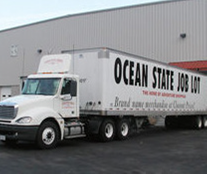Stable, Strong Wi-Fi Keeps Ever-Changing Inventory Moving In 1.2M Sq Ft Distribution Center

At a time when many big-name brick-and-mortar stores have closed, Ocean State Job Lot is flourishing. The closeout retailer has a devoted customer base that loves the “adventure shopping” experience that’s offered by Job Lot. Job Lot’s tractor trailers—emblazoned with “Home of Adventure Shopping”—crisscross New England, delivering products to over 135 stores. The privately held company, which just celebrated its 40th anniversary, stresses providing extraordinary value for hard-working families. And pursuit of value means that Job Lot doesn’t focus on specific product categories. Its merchandise is eclectic and surprising. Customers love the unexpected—and it keeps them coming back for a new adventure.
Now imagine the challenges of warehousing this constantly changing inventory of items of all shapes and sizes. All products are moved through Job Lot’s 1.2 million square foot distribution center in North Kingstown, Rhode Island. The building has 44-foot ceilings and storage space for 88,000 pallets of goods.
When Hugo Otero joined the company as senior network administrator, he was surprised to learn that the distribution center’s Wi-Fi was unreliable—to put it mildly. Employees use RF guns to scan inventory. “The Wi-Fi signals would constantly drop, forcing staff to stop scanning and walk around looking for a signal,” says Otero. “Clearly our Wi-Fi was in need of an upgrade.”
Otero reached out to Toby Burrell, sales director with SAB Solutions for recommendations on Wi-Fi providers to evaluate. SAB Solutions recommended Ruckus knowing that the Ruckus BeamFlex solution would outperform any vendor.
Ruckus signal strength conquers the vastness of (warehouse) space
A war ehouse can be a particularly hostile environment for Wi-Fi. Think vast spaces and lots of metal shelving, not to mention crates, boxes, packing material and electronics. SAB suggested wiring up one AP from each vendor and let the best signal win. “We walked around to see how far we could get before the signal weakened—or dropped entirely when it hit metal shelving or other interference,” says Burrell. The Ruckus signal strength left everyone else in the dust. “No other product came close to the Ruckus range. Frankly, we didn’t expect it to be that dramatic,” says Otero. “Their BeamFlex technology does an incredible job of extending coverage in this huge space. Ruckus APs mitigate interference better than anyone else we tested. They won on performance, no question.”
ehouse can be a particularly hostile environment for Wi-Fi. Think vast spaces and lots of metal shelving, not to mention crates, boxes, packing material and electronics. SAB suggested wiring up one AP from each vendor and let the best signal win. “We walked around to see how far we could get before the signal weakened—or dropped entirely when it hit metal shelving or other interference,” says Burrell. The Ruckus signal strength left everyone else in the dust. “No other product came close to the Ruckus range. Frankly, we didn’t expect it to be that dramatic,” says Otero. “Their BeamFlex technology does an incredible job of extending coverage in this huge space. Ruckus APs mitigate interference better than anyone else we tested. They won on performance, no question.”
Once the Ruckus APs were deployed, employees were able to connect and stay connected. “We solved the productivity problem like flipping a switch,” says Otero. “We also installed Ruckus outdoor APs that covered the whole trucking depot, where there was no Wi-Fi previously,” says Otero. “The trucks are located in multiple lots, and they have continuous coverage as they move from lot to lot.”
Discovery of the unexpected value
Getting the value and performance you expect from a product is a great feeling. But it’s pretty exhilarating to get value beyond what you expected.
For example, Otero’s team is looking at using the integrated mesh capability in Ruckus APs to link wirelessly from headquarters to a remote R&D facility, saving on the cost of cabling between the two buildings.
The Ruckus ZoneDirector management system is enabling the IT team to respond faster to users. “Before, if we got a trouble ticket, we’d have to let the employee know that we’d look into the problem when we got back to the office. Now we can open support tickets wherever we are. Ruckus management has simple, well-designed workflow and automates a lot of repetitive, low-level tasks to save us time.” But, Otero adds, the IT team doesn’t actually spend much time troubleshooting problems with the Ruckus Wi-Fi. “The network pretty much runs itself. Even configuring and deploying new APs requires few steps and little time.”
The old Wi-Fi APs didn’t offer strong security, but now the IT team can set up SSIDs in minutes. “We have at least 15 SSIDs to segregate network traffic,” explains Otero. “We can keep network traffic in the distribution center separate from the corporate users. We can give vendors and guests network access whenever they’re on site. Being able to segment and secure network traffic so easily gives us a lot more flexibility in how we do business internally and with external partners.”
---
Other Barcode news of interest:
- AIM Selected as International Registration Authority for RFID Standard
- AIM North America Honors NATO as 2019 Organization of the Year
- ID Technology Introduces 255ST Label Printer Applicator #PackExpo
- Asset Panda in Top 100 For Inc. Magazine’s Annual List Of Fastest-Growing Private Companies
- Global coding and marking equipment Expected to Record CAGR over 7% during 2019-2023
- RF Controls Announces Strategic Partnership with RTV Engineering
- Skyhawk Kiwi Remote Asset Monitoring Device Now Available
